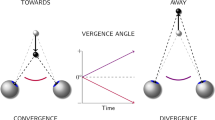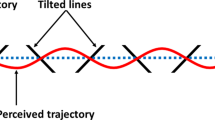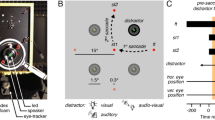Abstract
AS applied to eye guidance, Helmholtz's classical empirical theory of space perception1 contains two basic assumptions: first, that direction and location in space are learned by temporal association between visual and tactile experience, and second, that the two eyes are exactly conjugate in their response to visual stimuli. The second assumption is logically necessary because the theory of temporal association permits no time discrepancy between the two eyes in forming visual and tactual associations. If such binocular differences did occur, each eye would “learn” separate directions. We have set out to test this second assumption.
This is a preview of subscription content, access via your institution
Access options
Subscribe to this journal
Receive 51 print issues and online access
$199.00 per year
only $3.90 per issue
Buy this article
- Purchase on Springer Link
- Instant access to full article PDF
Prices may be subject to local taxes which are calculated during checkout
Similar content being viewed by others
References
Von Helmholtz, H. L. F., Treatise on Physiological Optics (translation from third German edition, edit. by Southall, J. P. C.) (Opt. Soc. Amer., Rochester, New York, 1924–1925).
Smith, K. U., in Acquisition of Skill (edit. by Bilodeau, E.) (Academic Press, New York, 1966).
Smith, K. U., Putz, V., and Molitor, K., Experimental Systems Analysis of Yoked Vision (University of Wisconsin Behavioral Cybernetics Laboratory, Madison, Wisconsin, 1966).
Smith, K. U., and Smith, M. F., Cybernetic Principles of Learning and Educational Design (Holt, Rinehart and Winston, New York, 1966).
Hyde, J. E., Amer. J. Ophthal., 48, 85 (1959).
Young, L. R., and Stark, L., IEEE Trans. Human Factors Eng., 4, 38 (1963).
Author information
Authors and Affiliations
Rights and permissions
About this article
Cite this article
SMITH, K., SCHREMSER, R. & HUANG, A. Experiments in Binocular Synchronization. Nature 228, 1339–1341 (1970). https://doi.org/10.1038/2281339a0
Received:
Revised:
Issue Date:
DOI: https://doi.org/10.1038/2281339a0
Comments
By submitting a comment you agree to abide by our Terms and Community Guidelines. If you find something abusive or that does not comply with our terms or guidelines please flag it as inappropriate.



